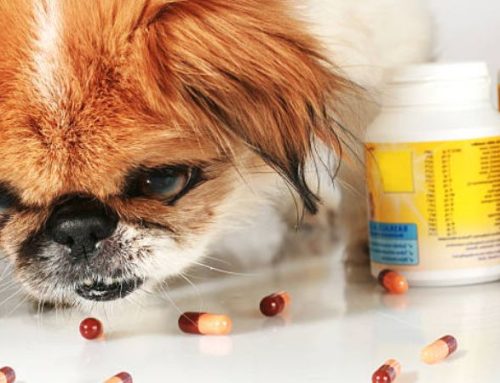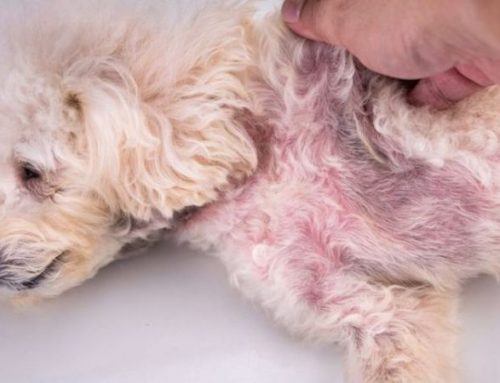When a dog’s mammary glands become swollen, tender, or unusually warm, it’s more than just a nuisance it could be mastitis, a condition that can cause serious discomfort and even threaten the health of both mother and puppies. Often triggered by infection, trauma, or milk buildup, mastitis can appear suddenly and progress quickly if left untreated.
Understanding the early warning signs, treatment options, and preventive steps is crucial for keeping your dog healthy and ensuring her pups thrive. Read on for the essential guide to mastitis in dogs: symptoms, home care, veterinary treatment, and prevention tips.
What is Mastitis in Dogs?
Mastitis in dogs is an inflammation or infection of one or more of the mammary glands (breasts). This condition most often affects nursing female dogs (bitches) during the postpartum period, when the mammary glands are producing milk for puppies. However, it can also develop in non-pregnant or non-lactating dogs due to hormonal imbalances, trauma, or infection.
When the mammary glands become inflamed, they may appear swollen, warm, and painful to the touch. In many cases, mastitis occurs when bacteria enter the teat through small cuts or abrasions, leading to infection and milk contamination. Without timely treatment, the infection can spread rapidly and cause serious illness.
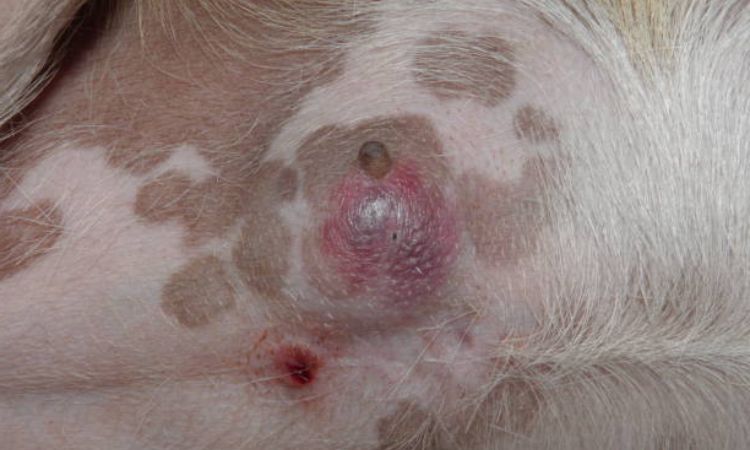
Types of Canine Mastitis
Veterinarians classify mastitis in dogs into several types based on the cause and severity of the inflammation:
1. Acute Mastitis
This is a sudden and painful inflammation of the mammary gland. The affected area may feel firm, hot, or swollen, and the milk may appear discolored, thick, or contain pus. Dogs with acute mastitis often show signs of discomfort, loss of appetite, and reluctance to nurse their puppies.
2. Septic Mastitis (Infectious Mastitis)
Septic mastitis is caused by bacterial infection, typically from pathogens such as Staphylococcus aureus or E. coli. This type of mastitis can result in systemic illness, with symptoms such as fever, lethargy, vomiting, or dehydration. The infection may spread through the bloodstream if untreated, making it a veterinary emergency.
3. Galactostasis (Non-Infectious Mastitis)
Also known as milk stasis, galactostasis occurs when milk builds up within the mammary glands, causing swelling and discomfort but no bacterial infection. It commonly happens when puppies are suddenly weaned or when there’s an imbalance between milk production and nursing demand. The mammary glands may feel firm and enlarged, but the dog generally does not show signs of illness.
4. Gangrenous Mastitis
This is the most severe and life-threatening form of mastitis. It occurs when blood flow to the affected tissue is cut off due to severe infection or necrosis, causing the mammary gland and surrounding tissue to turn dark purple or black. A foul odor, fever, and signs of shock may accompany this condition. Immediate emergency veterinary treatment is required, as the infection can become fatal if not managed promptly.
Recognizing the Signs of Mastitis in Dogs
Mastitis can be challenging to identify early, but recognizing the local, systemic, and puppy-related symptoms is crucial for prompt treatment. Understanding these signs can help dog owners intervene quickly and seek veterinary care before the condition worsens.
Local Symptoms (Mammary Glands)
Mastitis primarily affects the mammary glands, and the signs are often the first indicators:
- Swelling, Firmness, and Heat: The affected gland(s) may feel hard, swollen, and warm or hot to the touch. This is caused by inflammation and milk accumulation, making the area tender.
- Pain: Mothers may resist nursing their puppies, pull away when touched, or even whine or show mild aggression if the area is handled. Pain is a common early symptom, especially in acute or septic mastitis.
- Discolored or Abnormal Milk: Milk from infected glands may appear blood-tinged, pus-like, clumpy, or unusually colored (yellow, green, or brown). These changes indicate infection or inflammation in the mammary tissue.
- Skin Changes: The skin over the mammary gland may exhibit redness, bruising, or ulceration. In severe cases, tissue may darken, signaling gangrenous mastitis, which requires emergency veterinary care.

Systemic Symptoms (General Sickness)
As mastitis progresses, it can affect the mother’s overall health:
- Fever and Elevated Body Temperature: A common sign of bacterial infection, often accompanying septic mastitis.
- Lethargy or Weakness: The dog may appear tired, unwilling to move, or reluctant to interact with her puppies.
- Loss of Appetite (Anorexia) and Dehydration: Pain, fever, and illness may lead to reduced food and water intake, making early intervention essential.
- Neglecting Pups: Mothers with systemic illness may ignore their puppies or provide insufficient care, which can impact neonatal survival.
Puppy Symptoms (The First Clue)
Often, the first noticeable signs of mastitis may come from the puppies themselves:
- Failure to Thrive or Gain Weight: Puppies may cry frequently, appear weak, or fail to gain weight at the expected rate due to reduced or poor-quality milk from affected glands.
- Nursing Difficulties: Puppies may struggle to feed from painful or inflamed teats, signaling that mothers need immediate veterinary attention.
Causes and Risk Factors for Canine Mastitis
1. Bacterial Infections
The most common cause of mastitis in dogs is a bacterial infection. Pathogens such as Escherichia coli, Staphylococcus spp., Streptococcus spp., and Enterococcus can enter the mammary gland through the teat canal, often following minor trauma. Infections can trigger septic mastitis, causing pain, swelling, abnormal milk, fever, and systemic illness in the mother.
2. Fungal Infections
Although less common than bacterial infections, fungal pathogens like Blastomyces and Mycobacterium can cause inflammation of the mammary tissue, especially in immunocompromised or stressed dogs.
3. Trauma to the Teat or Mammary Gland
Physical injury to the teat or gland is a significant trigger. Trauma can occur from:
- Puppies scratching or biting while nursing
- Sharp edges or rough surfaces in the whelping area
- Accidental bumps or abrasions during handling
Damaged tissue allows bacteria or fungi to invade, increasing the risk of infection.
4. Milk Stasis (Over-Accumulation of Milk)
Excess milk accumulation can lead to galactostasis, where the mammary glands become swollen, firm, and painful. Milk stasis can trigger inflammation even in the absence of infection and is particularly common if puppies are weaned too early or fail to nurse effectively.
5. Unsanitary or Damp Whelping Environments
A dirty, wet, or poorly maintained birthing area increases the likelihood of bacterial contamination. Pathogens thrive in damp conditions, making it easier for infections to develop in exposed mammary tissue.
6. Loss of Puppies
The loss of one or more puppies can contribute to mastitis by creating milk overproduction or retention, which can lead to inflammation or secondary bacterial infection.
7. Pseudopregnancy (Phantom Pregnancy)
Even non-pregnant dogs can develop mastitis during false pregnancies, also known as pseudopregnancies. Hormonal changes can cause mammary gland swelling and, in some cases, secondary inflammation or infection.
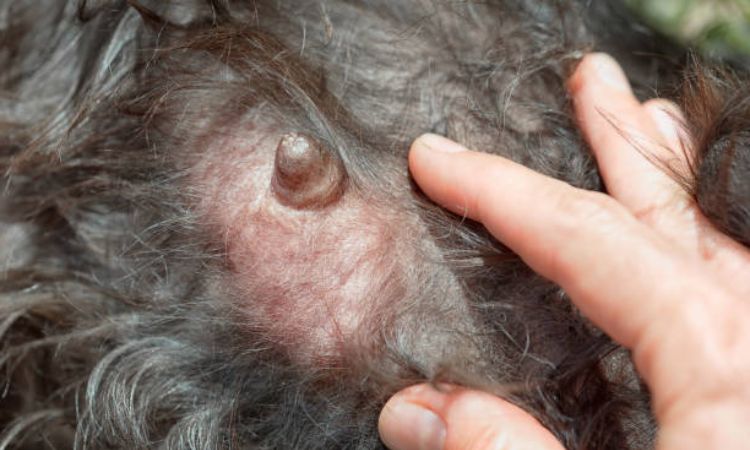
Veterinary Diagnosis of Mastitis
Accurate diagnosis is essential for effective treatment of mastitis in dogs. Veterinarians rely on a combination of physical examination, laboratory tests, and imaging techniques to determine the severity, type, and underlying cause of the condition.
Physical Exam and History
The first step in diagnosing mastitis involves a thorough physical examination of the mother dog. The veterinarian will:
- Inspect and palpate the mammary glands for swelling, firmness, heat, redness, or ulceration
- Assess for pain or tenderness when the glands or teats are touched
- Note any discolored or abnormal milk (blood-tinged, pus-like, clumpy, or otherwise unusual)
- Evaluate the mother’s overall health, including fever, lethargy, and appetite
- Collect a detailed history, including:
- Pregnancy and whelping details
- Nursing behavior of puppies
- Any previous mastitis episodes
- Environmental conditions, hygiene, and potential trauma
This combined history and exam help the veterinarian identify whether mastitis is acute, septic, chronic, or gangrenous.
Milk Cytology and Culture
Milk samples are critical in confirming infection and guiding treatment:
- Cytology: Microscopic examination of milk reveals an increase in degenerative neutrophils and the presence of bacteria or, in rare cases, fungi
- Microbial culture: Identifies the specific bacterial or fungal species causing mastitis
- Antimicrobial susceptibility testing: Determines which antibiotics will be most effective, ensuring safe and targeted therapy for both mother and nursing puppies
Even milk that appears normal should be tested if mastitis is suspected, as subclinical infections may not show obvious signs.
Blood Work (CBC)
Blood tests provide insight into the mother dog’s systemic health and can help detect complications:
- Complete Blood Count (CBC):
- Elevated white blood cell (WBC) count indicates infection or inflammation
- Platelet abnormalities may suggest severe infection, including gangrenous mastitis or sepsis
- Biochemistry panels: Assess organ function and hydration status, which may be affected in severe or systemic cases
Blood work is particularly important in severe mastitis cases where systemic illness, fever, or lethargy is present.
Ultrasound
Ultrasound imaging is a non-invasive tool that helps evaluate the extent of mammary gland damage and detect complications:
- Determines the presence of abscesses, fluid accumulation, or tissue necrosis
- Evaluates blood flow and tissue structure, which helps distinguish between inflammatory mastitis and more serious conditions, such as mammary tumors
- Guides treatment decisions, including whether surgical intervention is necessary
Ultrasound is often used alongside cytology, culture, and blood work to provide a comprehensive diagnostic picture.
Mastitis Treatment Options (Home Care & Veterinary)
Immediate Veterinary Care is Essential
Mastitis should always be evaluated and treated by a veterinarian as early as possible. Early intervention improves recovery outcomes and prevents the infection from spreading to other mammary glands or causing systemic illness.
Antibiotics
- Mastitis is most often caused by bacterial infection (e.g., Staphylococcus aureus, Escherichia coli, Streptococcus spp.).
- Your veterinarian will prescribe broad-spectrum antibiotics that are safe for nursing puppies if necessary.
- Common antibiotics include cephalexin or amoxicillin-clavulanate, but the choice depends on culture and sensitivity testing of the milk or affected tissue.
- Full course adherence is crucial to prevent recurrence or antibiotic resistance.
Pain Medication (NSAIDs)
- Pain relief is an important component of mastitis treatment to reduce inflammation and improve the mother’s comfort.
- Non-steroidal anti-inflammatory drugs (NSAIDs) may be prescribed, taking care to select medications safe for nursing puppies.
- Keeping a pain management log ensures accurate dosing and prevents accidental overmedication.
Hand-Milking
- Expressing milk manually from affected glands helps relieve congestion, reduce swelling, and prevent milk stasis.
- The vet can demonstrate proper hand-milking techniques to ensure safe and effective drainage.
- Massage around the teat can stimulate lactation and maintain soft, healthy mammary tissue.
Supportive Home Care
Even under veterinary supervision, home care is essential to promote healing and prevent further infection.
Warm Compresses
- Apply a clean cloth soaked in warm water to affected mammary glands for comfort and improved milk flow.
- Reapply as long as the cloth is warm and clean. Warm compresses can reduce pain and encourage drainage.
Encourage Nursing
- Frequent nursing prevents milk buildup, which can worsen inflammation.
- If the mother is reluctant or unable to nurse all puppies, hand-milking and supplemental feeding for the puppies may be required.
Clean Environment
- Maintain a clean, dry, and sanitary whelping area to reduce bacterial exposure.
- Wash bedding daily and remove any urine or feces promptly.
- Trim puppies’ nails to prevent teat trauma during nursing.
Treatment for Severe Cases
In advanced or complicated cases, more intensive veterinary intervention may be necessary.
Hospitalization
- For severe mastitis or systemic infection, hospitalization may include:
- IV fluids for dehydration
- Pain management via injections
- Continuous monitoring of vital signs and overall condition
Surgery
- Surgical intervention may be required in cases of abscess, gangrenous tissue, or teat rupture.
- Procedures may include drainage, debridement, and removal of necrotic tissue.
- Post-surgery, careful monitoring, antibiotics, and supportive care are essential for recovery.
Mastitis treatment in dogs requires a combination of timely veterinary care and attentive home support. Antibiotics, pain relief, hand-milking, warm compresses, and a clean environment can effectively manage most cases, while severe infections may require hospitalization or surgery. Early recognition and prompt treatment are essential to ensure the health and wellbeing of both the mother and her puppies.
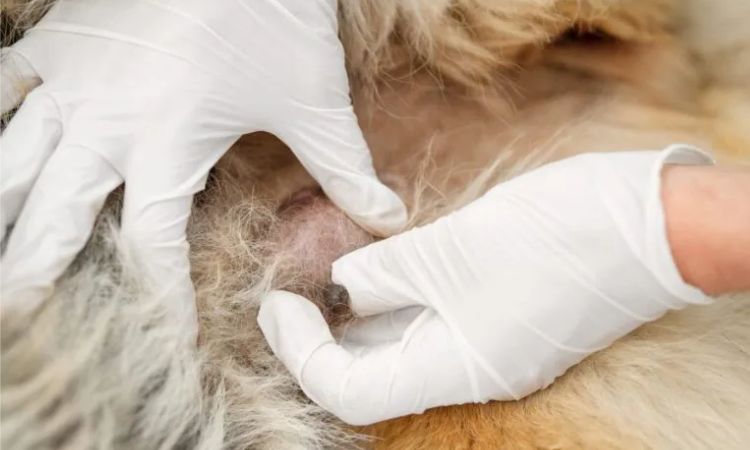
Prevention: How to Keep Your Nursing Dog Healthy
Mastitis is an inflammation or infection of the mammary glands that can be painful and even life-threatening for nursing dogs. While some risk factors are unavoidable, proper care and preventive measures can greatly reduce the likelihood of mastitis.
1. Maintain a Clean Whelping Environment
- Sanitize the whelping box regularly to reduce exposure to bacteria and fungi.
- Change bedding daily, especially if it becomes soiled or damp.
- Keep the area dry and free from sharp edges or contaminants that could injure the teats.
2. Monitor Nursing Puppies
- Ensure all puppies are nursing evenly from all teats to prevent milk stasis.
- Rotate puppies if some are neglecting certain teats, allowing all glands to be drained properly.
- Trim puppies’ nails to minimize scratching and injury to the teats.
3. Gradual Weaning
- Avoid abrupt weaning of puppies, as sudden milk accumulation can lead to non-septic mastitis.
- Reduce nursing gradually over several days or weeks to allow mammary tissue to adjust.
4. Monitor the Mother Dog
- Check the mother daily for signs of discomfort, swelling, or abnormal milk.
- Observe her appetite, behavior, and interest in puppies, as systemic illness can indicate early mastitis.
- Keep her clean and groomed, especially around the mammary area.
5. Proper Nutrition and Hydration
- Feed a high-quality, balanced diet suitable for lactating dogs.
- Ensure the mother has constant access to fresh water, as hydration supports milk production and general health.
6. Minimize Stress and Trauma
- Handle the mother gently to avoid physical trauma to the teats or mammary glands.
- Keep the whelping environment calm and quiet, reducing stress which may affect immune response.
7. Early Veterinary Intervention
- Schedule postpartum veterinary checkups to identify any early signs of infection.
- Consult a veterinarian promptly if you notice:
- Swelling, warmth, or hardness in the mammary glands
- Discolored or bloody milk
- Fever, lethargy, or refusal to nurse
- Early treatment can prevent progression to septic or gangrenous mastitis.
Preventing and managing mastitis is essential for the health of both mother and puppies. By recognizing early signs, providing prompt veterinary care, and maintaining a clean, supportive environment, you can reduce risks and ensure a safe, comfortable postpartum period for your dog.


